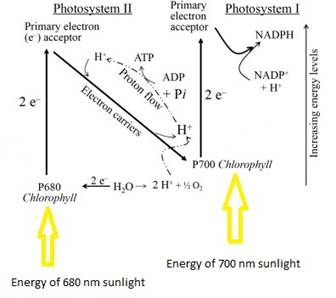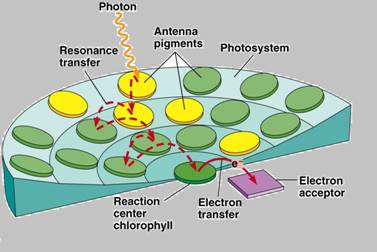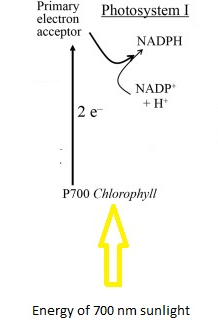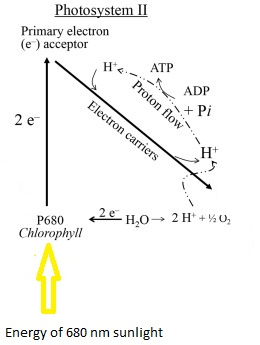
Concept explainers
(a)
Interpretation:
The most suitable matching pair should be selected.
Concept introduction:
Photosynthesis is the process by whichenergy of the sunlight is stored as chemical energy. The process takes place in the chloroplast of the plant cells in two main stages - light reaction and dark reaction.
Answer to Problem 8P
a) Light reactions − generates ATP, NADPH and O2
Explanation of Solution
Photosynthesis consists of two main stages - light reaction and dark reaction.
In light reaction, two photo systems (PS I and PS II) participate.
PSII absorb680 nmwavelengthof sunlight. After absorbing energy from the sunlight, chlorophyll a molecule in PSII release excited high energy electrons. The electron defect occurred in PSII is fulfilled by hydrolysis of water which produce O2as by product. Consider this as reaction 1.
Theelectronsfrom reaction I are used to fulfill the electron defect inphotosystem. The high energy electrons go through the series of electron acceptorsto assimilate this energy. ADP takes up the energy of these electrons to form ATP. This is known as photophosphorylation.
Similar reaction occurs in PS I. PSI absorb 700 nm wavelength of sunlight, followed by high energy electrons release. Like PSII, the high energy electron goes through a series of electron acceptors. At the end of this series NADP+accepts the electron to form NADPH. Consider this as reaction 2.

Figure 1: A diagrammatic representation of light reaction
(b)
Interpretation:
The most suitable matching pair should be selected.
Concept introduction:
Photosynthesis is the process by which energy of the sunlight is stored as chemical energy. The process takes place in the chloroplast of the plant cells in two main stages - light reaction and dark reaction.
Answer to Problem 8P
b) Chloroplasts − cellular location of photosynthesis
Explanation of Solution
Chloroplast is the organelle in a plant cell which is responsible for conducting photosynthesis. Chloroplast consists of a double membrane structure known as thylakoid. Thylakoids are the primary site for light reaction which assimilate the light energy to produce the energy moieties, ATP and NADPH. These energy molecules are used in the dark reaction to produce six carbon sugar molecule and oxygen as byproduct. The dark reaction takes place in the stroma of chloroplast.
(c)
Interpretation:
The most suitable matching pair should be selected.
Concept introduction:
Photosynthesis is the process by which energy of the sunlight is stored as chemical energy. The process takes place in the chloroplast of the plant cells in two main stages - light reaction and dark reaction.
Answer to Problem 8P
c) Reaction Center − site of photoinduced charge separation.
Explanation of Solution
In light reaction, two photosystems called PS I and PS II participate.
In these photosystems, the reaction center is a special chlorophyll a molecule, chlorophyll a. The process happening in these two systems is quite similar.
PSII absorbs light energy of 680 nm wavelength of light while PS I absorb energy of 700 nm wavelength of light, followed by releasing high energy electrons.
When the chlorophyll a molecule releases its electrons, the chlorophyll molecule gets positively charged. It generates the charge separation at the chlorophyll molecules. This charge separation is due to the absorbed light energy. So, it is known as photo induced charge separation.
A photosynthetic reaction center is a complex structural view. It is composed of several proteins, pigments and other co-factors. It is a collection of CF1− CF0 complex. This is responsible for executing the primary energy conversion reactions related to photosynthesis. Molecular excitations occur at the reaction center give rise to electron transfer reactions along the path of a series of protein-bound co-factors like chlorophylls.
(d)
Interpretation:
The most suitable matching pair should be selected.
Concept introduction:
Photosynthesis is the process by which energy of the sunlight is stored as chemical energy. The process takes place in the chloroplast of the plant cells in two main stages - light reaction and dark reaction.
Answer to Problem 8P
d) Light-harvesting complex- Primary photosynthetic pigment
Explanation of Solution
Photosynthesis is the process by which energy of the sunlight is stored as chemical energy. The process takes place in the chloroplast of the plant cells in two main stages - light reaction and dark reaction. In the light reaction, the sunlight is assimilated, and the energy is stored in the
The photosynthetic pigments such as chlorophyll a and b, xanthophyll and carotenoids form the two photosystems (Photosystem I and II) which absorbs different wavelength of light. Chlorophyll a form the reaction center of the photosystems.
(e)
Interpretation:
The most suitable, matching pair of answers should be selected.
Concept introduction:
A light-harvesting complex is a collection of subunit proteins. These subunit proteins are again a part of largersupercomplex of a photosystem.
Answer to Problem 8P
e) Light − harvesting complex − uses resonance energy transfer to reach the reaction center
Explanation of Solution
A light-harvestingcomplex (also known as photosystem)is a collection of proteins.The light harvest system is used by plants and photosynthetic bacteria to collect energy from sun light. During photosynthesis, the reaction centers absorbs light energy of 680nm and 700 nm sun light. This reaction center is a special chlorophyll a molecule. Light harvesting complex assist on this energy absorbance.
Light-harvesting complexes show a huge variation among the different photosynthetic organisms. The complexes consist of proteins and photosynthetic pigments like chlorophylls and surround by the photosynthetic reaction center. This special structural adaptation is to focus energy, absorbed from the photons toward the reaction center as resonance transfer.

Figure 3: close view of a light harvesting complex
(f)
Interpretation:
The most suitable matching pair of answers should be selected.
Concept introduction:
Photosynthesis is the process by which energy of the sunlight is stored as chemical energy. The process takes place in the chloroplast of the plant cells in two main stages - light reaction and dark reaction.
For the light reaction two photosystems called PS I and PS II participate.
Answer to Problem 8P
f) Photosystem I − powers the formation of NADPH
Explanation of Solution
Photosystem is a collection of pigment moleculesand is known as light harvest complex. In photosystem I, PS I absorb energy from 700 nm photons of sunlight, followed by releasing high energy electrons. The electron goes through a series of electron acceptors. At the end of this series NADP reacts with electron to form NADPH.

Figure 4: Figure 5: Diagrammatic representation of reactions happen in photosystem one
(g)
Interpretation:
The most suitable, matching pair of answers should be selected.
Concept introduction:
Photosynthesis is the process by which energy of the sunlight is stored as chemical energy. The process takes place in the chloroplast of the plant cells in two main stages - light reaction and dark reaction.
For the light reaction two photosystems called PS I and PS II participate.
Answer to Problem 8P
g) Photosystem II − Transfer electron from H2O to P680.
Explanation of Solution
For the light reaction two photosystems called PS I and PS II participate. PSII absorbs light energy of 680 nm wavelength of sun light After absorbing energy the chlorophyll a molecule in PSII releases excited, high energy electrons. To fulfill the electron defect occurred at PSII water hydrolysistakes place at PSII.
These released electrons are used to overcome the electron defect in photosystemII.

Figure : Diagrammatic representation of reactions happen in photosystem one
(h)
Interpretation:
The most suitable, matching pair of answers should be selected.
Concept introduction:
The chloroplast cytochrome bf complex is a collection of multiple numbers of subunit proteins.
Answer to Problem 8P
h) Cytochrome bf complex − pumps protons
Explanation of Solution
The chloroplast cytochrome bf complex is a collection of multiple numbers of subunit proteins. These subunit proteinsconsist of four polypeptides. These four types are
- Cytochrome f
- Heme containing cytochrome b 6
- Rieske iron-sulfur protein
- 17 kD polypeptide
Most mechanisms suggest that the transfer of a single reducing equivalent which is an electron results in the translocation of two protons across the membrane. So, this complex mainly workes as a proton pump.
(i)
Interpretation:
The most suitable, matching pair of answers should be selected.
Concept introduction:
Photosynthesis is the process by storing energy of sunlight as chemical energy in glucose. Process happens in the chloroplast of a plant cell. Photosynthesis happens via two main stages as light reaction and dark reaction.
Answer to Problem 8P
i) Water -oxidizing complex- site of oxygen generation.
Explanation of Solution
For the light reaction, two photosystems called PS I and PS II participate. PSII absorbs light energy of 680 nm wavelength of sun light After absorbing energy the chlorophyll a molecule in PSII releases excited, high energy electrons. To fulfill the electron defect occurred at PSII water hydrolysis takes place at PSII.
The hydrolysis of water is taken care of by water oxidizing complex. Thereleased electrons are used to overcome the electron defect in photosystem II.
(j)
Interpretation:
The most suitable matching pair should be selected.
Concept introduction:
A photosynthetic reaction center is a complex structural. It is composed of several proteins, pigments and other co-factors. It is a collection of CF1− CF0complex.
Answer to Problem 8P
j) ATP synthase − CF1- CF0 complex
Explanation of Solution
A photosynthetic reaction center is a complex structural. It is composed of several proteins, pigments and other co-factors.It is a collection of CF1− CF0 complex. This is responsible for executing the primary energy conversion. The energy is stored in the form of ATP via this complex.
Want to see more full solutions like this?
Chapter 19 Solutions
BIOCHEMISTRY 2 TERM ACCESS
- Place the events of an action potential in order, starting and ending with a cell at its resting membrane potential. Cell starts at its resting membrane potential. Cell returns to its resting membrane potential. Answer Bank K+ channels fully open, and Na+ channels are inactivated. K* rushes out of the cell, causing repolarization. K+ channels close slowly, resulting in hyperpolarization. Na+ channel gates reset. Fast Na+ and slow K+ channels are activated. Na rushes into the cell, causing membrane depolarization. Ligand activation of the acetylcholine receptor depolarizes the membrane.arrow_forwardGlucose and fructose are reducing sugars. Sucrose, or table sugar, is a disaccharide consisting of both fructose and glucose. Is sucrose a reducing sugar? Why or why not? No, because only one anomeric carbon is involved in the glycosidic linkage. No, because both anomeric carbons are involved in the glycosidic linkage. Yes, because the fructose unit can convert to the open-chain form. Yes, because the glucose unit can convert to the open-chain form. Which statements about reducing sugars are true? The oxidation of a reducing sugar forms a carboxylic acid sugar. D-Arabinose (an aldose) is a reducing sugar. Reducing sugars contain keto groups instead of aldehyde groups. A disaccharide with its anomeric carbons joined by the glycosidic linkage cannot be a reducing sugar. A reducing sugar will not react with the Cu² + in Fehlings's reagent.arrow_forwardExamine the pairs of molecules and identify the more-reduced molecule in each pair. H-C- CH, OH CH HO-C-H CH₁₂ Pyruvate Ethanol Acetaldehyde Lactate COO H-C H H- -C-H COO- Succinate Fumarate -OOC COO H COO- H――000- CH₂ COO- Oxalosuccinate H-C-OH OOC-C-H CH₂ COO Isocitratearrow_forward
- Classify each description as characterizing facilitated diffusion, primary active transport, secondary active transport, or both primary and secondary active transport. Facilitated diffusion Primary active transport Secondary active transport Primary and secondary active transport Answer Bank requires ATP includes lactose permease directly uses ATP hydrolysis to pump substances across the membrane includes the Na+-K+ ATPase pump always moves more than one substance at a time movement of substances against an electrochemical gradient does not require energy input includes uniporters uses energy stored in electrochemical gradients generated by pumpsarrow_forwardCreatine is a popular dietary supplement. What is the biochemical rationale for the use of creatine? It would directly serve as an electron carrier to support the oxidation of fuel molecules and thus energy production. It would serve as an electron donor to support reductive biosyntheses required to sustain cellular function. It would be converted into creatine phosphate and thus serve as a rapid means of replenishing ATP during muscle contraction. It would promote the movement of ions through ion channels and thus power the synthesis of ATP during exercise. What type of exercise would benefit most from creatine supplementation? a leisurely walk sprinting yoga a long-distance runarrow_forwardAssign each statement to the corresponding polysaccharide. Chitin Starch Glycogen Cellulose Answer Bank is abundant in muscle and liver provides structural support for plants is the storage form of glucose in animals provides structural support for animals such as arthropods is a storage form of fuel in plant cells consists of N-acetylglucosamine residues comes in two forms: amylose and amylopectinarrow_forward
- Match each term with its description. has the molecular formula of (CHO), monosaccharides that differ at a single asymmetric carbon atom the storage form of glucose in animals the storage form of glucose in plants glycoprotein containing glycosaminoglycans the most abundant organic molecule in the biosphere N-acetylgalactosamine is a key component of this glycoprotein carbohydrate-binding proteins enzymes that synthesize oligosaccharides stereoisomers that are mirror images of each other Answer Bank lectins epimers starch mucoprotein carbohydrates glycogen glycosyltransferases cellulose enantiomers proteoglycanarrow_forwardComplete the sentences describing membrane lipids by moving the names of the lipids to the appropriate sentence. Some lipids will be used more than once, and some sentences will require you to place two or three lipids. Answer Bank include two fatty acids joined to glycerol by ester linkages. do not contain glycerol. is a steroid. contain a sphingosine backbone. contain one or more sugars. usually have branched alkyl chains. glycolipids phosphoglycerides sphingomyelin cholesterol archacal lipidsarrow_forwardThe protein content of most plasma membranes is, on average, about 50% by weight. Myelin has a protein content of about 18%, whereas the internal membranes of mitochondria and chloroplasts may be composed of 75% protein. Label the membrane proteins on the diagram. Answer Bank lipid-anchored protein peripheral membrane protein integral membrane proteinarrow_forward
- Why don’t we see amino acids with certain properties (e.g., a straight-chain side chain with two carbons, multiple hydroxyl groups, or other unusual structures)?arrow_forwardPlease analze the gel electrophoresis column of the VRK1 kinase (MW: 39.71 kDa). Lane 1: buffer Lane 2 : Ladder Lane 3: Lysate Lane 4: Flowthrough Lane 5: Wash Lanes 6-8: E1, E2, E3 Lane 9: Dialyzed VRK1 Lane 10: LDHarrow_forwardPlease helparrow_forward
 BiochemistryBiochemistryISBN:9781305577206Author:Reginald H. Garrett, Charles M. GrishamPublisher:Cengage Learning
BiochemistryBiochemistryISBN:9781305577206Author:Reginald H. Garrett, Charles M. GrishamPublisher:Cengage Learning
 Concepts of BiologyBiologyISBN:9781938168116Author:Samantha Fowler, Rebecca Roush, James WisePublisher:OpenStax College
Concepts of BiologyBiologyISBN:9781938168116Author:Samantha Fowler, Rebecca Roush, James WisePublisher:OpenStax College Biology (MindTap Course List)BiologyISBN:9781337392938Author:Eldra Solomon, Charles Martin, Diana W. Martin, Linda R. BergPublisher:Cengage Learning
Biology (MindTap Course List)BiologyISBN:9781337392938Author:Eldra Solomon, Charles Martin, Diana W. Martin, Linda R. BergPublisher:Cengage Learning Biology 2eBiologyISBN:9781947172517Author:Matthew Douglas, Jung Choi, Mary Ann ClarkPublisher:OpenStax
Biology 2eBiologyISBN:9781947172517Author:Matthew Douglas, Jung Choi, Mary Ann ClarkPublisher:OpenStax Biology: The Dynamic Science (MindTap Course List)BiologyISBN:9781305389892Author:Peter J. Russell, Paul E. Hertz, Beverly McMillanPublisher:Cengage Learning
Biology: The Dynamic Science (MindTap Course List)BiologyISBN:9781305389892Author:Peter J. Russell, Paul E. Hertz, Beverly McMillanPublisher:Cengage Learning





